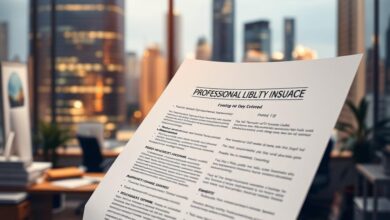Understand Your Business Liability Insurance Policy
Protecting your business from unexpected risks and financial losses is key.
A business liability insurance policy offers the needed liability coverage to protect your company’s assets.
Having the right liability coverage is vital for businesses of all sizes and types.
This article will cover the basics of business insurance and what you can expect from your insurance policy.
Key Takeaways
- Understand the importance of liability coverage for your business.
- Learn how a business liability insurance policy can protect your company’s assets.
- Discover the key elements of a complete business insurance policy.
- Find out what to expect from your insurance provider.
- Gain insights into the benefits of having the right liability coverage.
The Fundamentals of Business Liability Protection
As a business owner, understanding liability coverage is key to protecting your assets. This type of insurance shields your company from financial losses. It covers lawsuits, accidents, and other unexpected events.
Why Every Business Needs Liability Coverage
Liability coverage is essential for all businesses. It protects against expensive lawsuits and financial losses. Without it, a single lawsuit could ruin a business. Here are some reasons why businesses need it:
- Protection against customer or third-party claims
- Coverage for legal fees and expenses
- Financial protection in case of accidents or property damage
Legal Requirements Across Different States
Liability insurance laws differ by state. It’s important to know these laws to stay compliant.
Mandatory Coverage Thresholds
Some states require a certain amount of coverage. Businesses must meet these thresholds.
Industry-Specific Requirements
Some industries, like construction or healthcare, face stricter rules. For example, a construction company might need a lot of liability coverage to operate.
Types of Business Liability Insurance Policies
Businesses face many risks. It’s important to know about the different types of business liability insurance. These policies help protect businesses from unexpected financial losses.
General Liability Insurance
General liability insurance is key for businesses. It covers a wide range of risks. It includes:
- Third-Party Bodily Injury Protection: Covers medical costs for injuries to third parties on your premises.
- Property Damage Coverage: Protects against damages to third-party property.
Third-Party Bodily Injury Protection
This coverage is key for businesses with customers. It protects against claims from accidents on the premises.
Property Damage Coverage
Property damage coverage is vital for businesses. It covers damages to other people’s property during operations.
Professional Liability Insurance
Professional liability insurance, also known as errors and omissions insurance, protects businesses. It covers claims of negligence or errors in professional services.
Product Liability Insurance
Product liability insurance is key for businesses that make or sell products. It protects against claims from product defects or failures.
Employment Practices Liability
Employment practices liability insurance protects businesses. It covers claims related to employment practices, like wrongful termination or discrimination.
Knowing about these types of business liability insurance policies helps business owners. It helps them choose the right coverage for their needs.
How to Read Your Business Liability Insurance Policy
Understanding your business liability insurance policy is key. It can protect you or leave you exposed. Knowing what your policy covers is essential.
Navigating the Declarations Page
The declarations page is the first part of your policy. It shows your coverage details, like the policy period and limits. Make sure to check this page for accuracy and to meet your expectations.
Understanding Insuring Agreements
Insuring agreements explain what your policy covers. They tell you when the insurance company will pay for claims. It’s important to read these agreements to know your protection level.
Identifying Critical Exclusions
Exclusions in your policy list what’s not covered. Knowing these exclusions is key to avoiding coverage gaps. For example, an exclusion for certain claims could leave your business at risk.
Deciphering Endorsements and Riders
Endorsements and riders change your policy. They can add or subtract coverage. It’s important to understand these changes to know your full protection.
Common Endorsements to Consider
Some endorsements add coverage for extra insured parties or changes in business. Others enhance specific coverage. Reviewing these endorsements helps you understand your coverage better.
Red Flags in Policy Language
Be careful of unclear or restrictive policy language. Look out for clauses that could limit your coverage or create loopholes.
| Policy Component | Description | Importance |
|---|---|---|
| Declarations Page | Summary of coverage details | High |
| Insuring Agreements | Outlines scope of coverage | High |
| Exclusions | Specifies what is not covered | High |
| Endorsements and Riders | Amendments to policy coverage | Medium |
Understanding Coverage Limits and Deductibles
Coverage limits and deductibles are key to protecting your business from unexpected costs. Knowing about these parts is vital to make sure your insurance covers you well.
Per Occurrence vs. Aggregate Limits
Liability insurance for businesses has two main limits: per occurrence and aggregate. Per occurrence limits are the max an insurer pays for one claim. Aggregate limits are the total for all claims in a policy period.
For example, if your policy has a $1 million per occurrence limit and a $2 million aggregate limit, the insurer covers up to $1 million for any single claim. They also cover a total of $2 million for all claims during the policy term.
Selecting the Right Deductible Amount
Choosing the right deductible is a trade-off between cost and risk. A higher deductible lowers your premium but means you pay more if you make a claim.
Balancing Premium Costs with Risk Exposure
When picking a deductible, think about your business’s money situation and how much risk you can handle. A lower deductible might be better for businesses with less money. Those with more money might choose a higher deductible to save on premiums.
| Deductible Amount | Premium Cost | Risk Exposure |
|---|---|---|
| $1,000 | $500 | Low |
| $5,000 | $300 | Moderate |
| $10,000 | $200 | High |
Additional Insured Requirements
Additional insured requirements are important for your business liability insurance. They involve adding others, like clients or vendors, to your policy. This protects them from liability claims related to your business.
Assessing Your Specific Business Liability Risks
To protect your business, you need to know the risks it faces. This helps you choose the right insurance. It keeps your business safe from financial losses.
Industry-Specific Risk Factors
Different industries have their own risks. For example, construction sites face accidents, while software companies worry about data breaches. Knowing these industry-specific risk factors is key to understanding your business’s risks.
Business Size and Structure Considerations
The size and structure of your business matter too. Bigger businesses or complex ones face more risks. They have more employees, customers, or operations. It’s important to think about these when assessing your risks.
Step-by-Step Risk Assessment Process
Doing a thorough risk assessment involves several steps. First, find out what risks you face. Then, see how likely and impactful they are. Lastly, decide which ones need the most coverage.
Creating a Risk Matrix
A risk matrix helps you see and sort risks. It plots the likelihood and impact of each risk. This way, you can focus on the most important ones to cover.
After identifying and evaluating your risks, it’s time to decide what coverage you need. You should figure out which risks are most important to your business. Then, make sure you have enough insurance to protect against those risks.
| Risk Factor | Likelihood | Impact | Priority |
|---|---|---|---|
| Data Breach | High | Severe | Critical |
| Employee Injury | Medium | Moderate | High |
| Product Liability | Low | Minor | Low |
Steps to Ensure Your Business Liability Insurance Policy Provides Adequate Protection
To protect your business, it’s key to know how to keep your liability insurance up to date. Making sure your policy fits your business needs is vital for reducing risks.
Working with an Insurance Professional
Working with a skilled insurance professional can greatly improve your understanding of your policy. They can also help make sure your policy matches your business’s unique needs. They know which coverages are best for your industry and how your business operates.
Conducting Regular Policy Reviews
It’s important to regularly check your liability insurance policy. Annual assessments can spot any coverage gaps.
Annual Assessment Checklist
- Review business operations and risk exposure
- Update policy limits as necessary
- Assess new or changed business activities
Addressing Coverage Gaps
Finding and fixing coverage gaps is key to keeping your business safe. You need to know what your policy doesn’t cover and make sure there are no big gaps.
Preparing for the Claims Process
Knowing how to handle claims is important for your business. This means understanding what documents you need and when to report claims.
Documentation Requirements
Keeping good records of incidents and claims is essential for a smooth claims process.
Reporting Timelines
Knowing when to report claims can help avoid problems with your insurer.
Protecting Your Business with the Right Liability Insurance
It’s key to understand and manage your business liability insurance policy. This is vital for protecting your business from risks. We’ve covered the basics of business liability protection, types of policies, and how to read your policy.
By following the guidelines, businesses can handle liability insurance better. Regularly checking your policy makes sure it fits your business needs. This step helps protect your business from unexpected events and financial losses.
In conclusion, having the right business liability insurance is critical. Knowing your policy well and staying updated helps you make smart decisions. This way, you can effectively protect your business.









